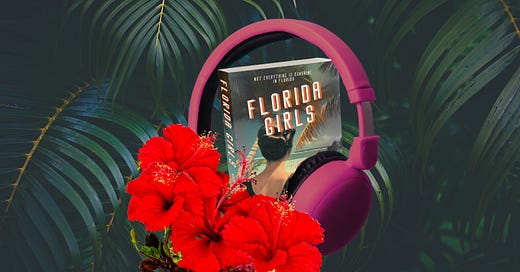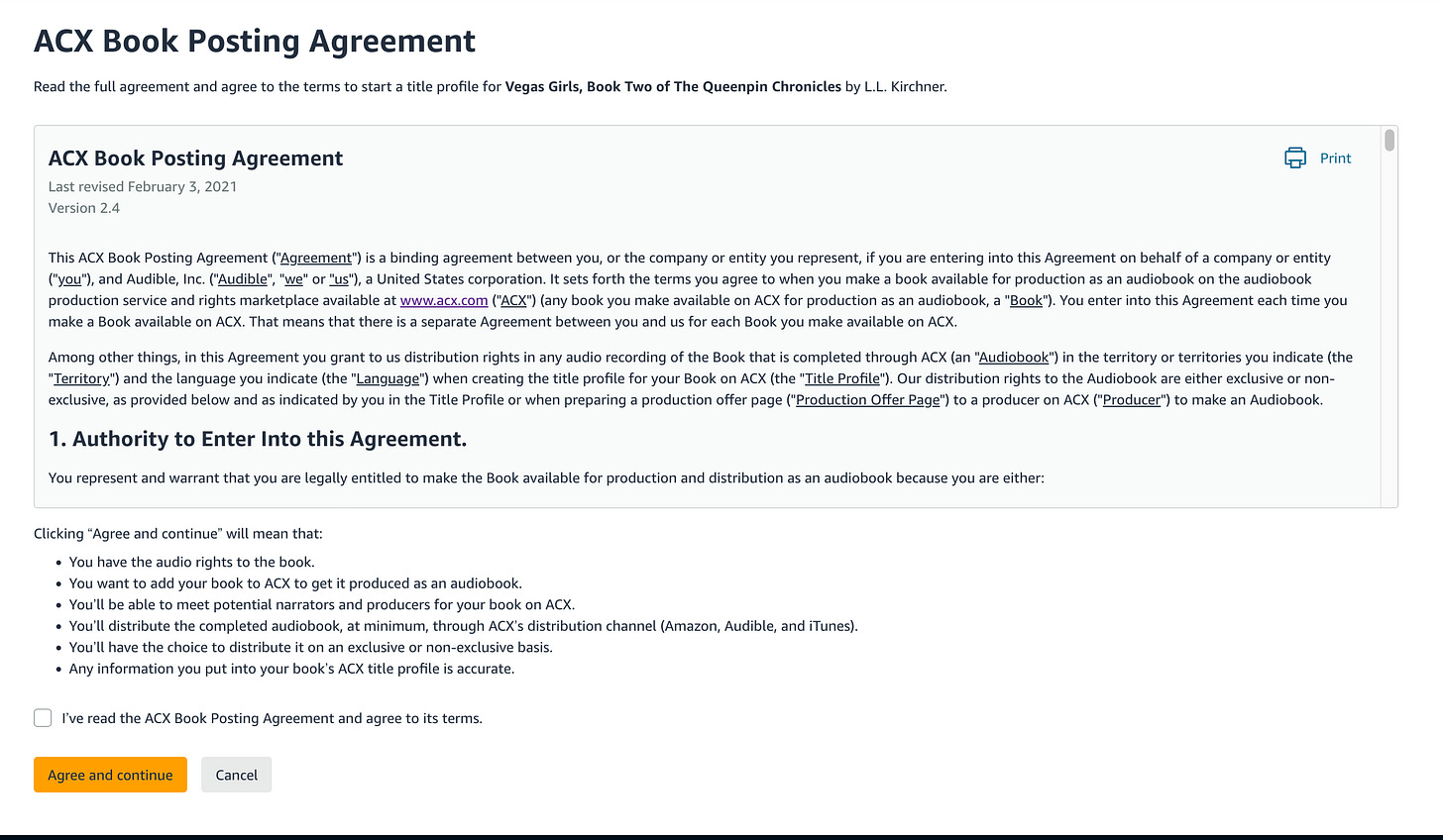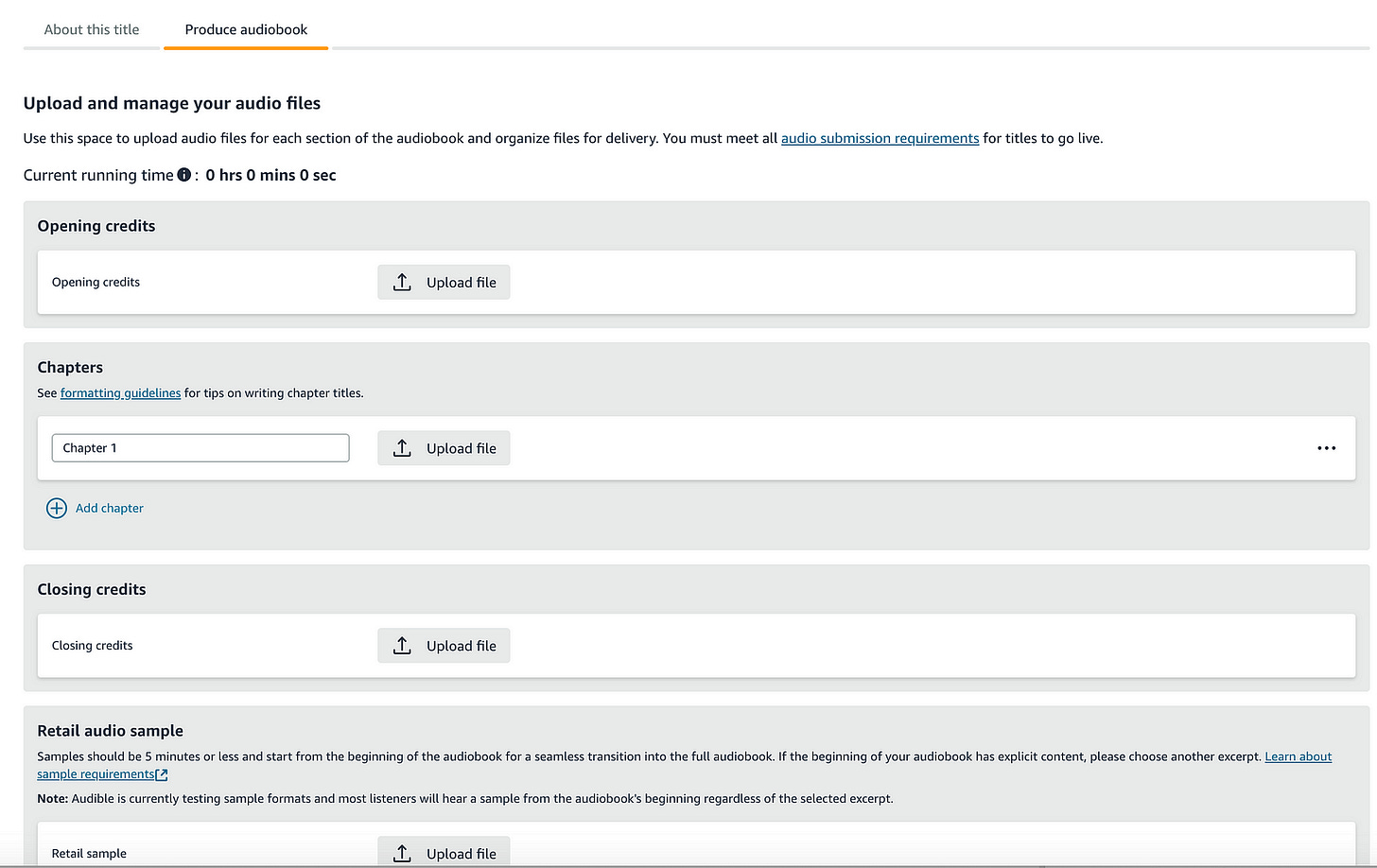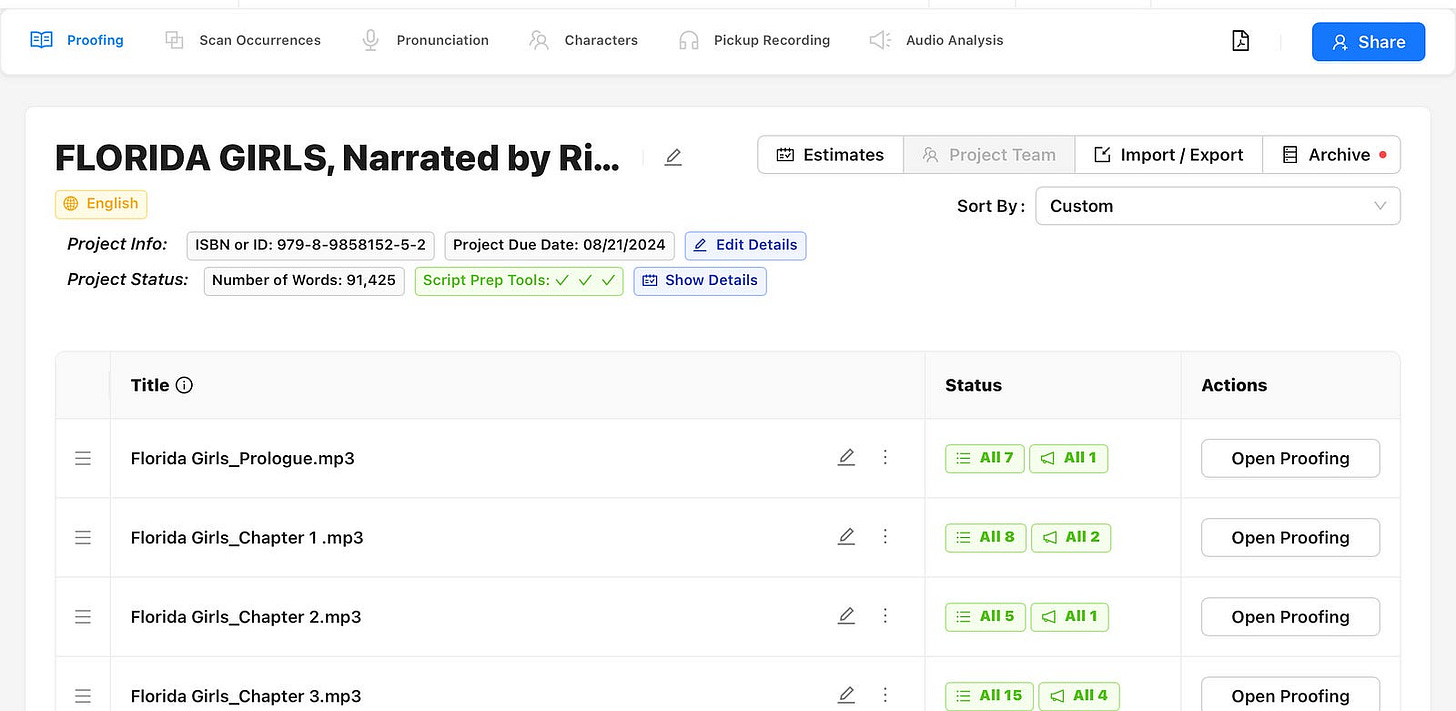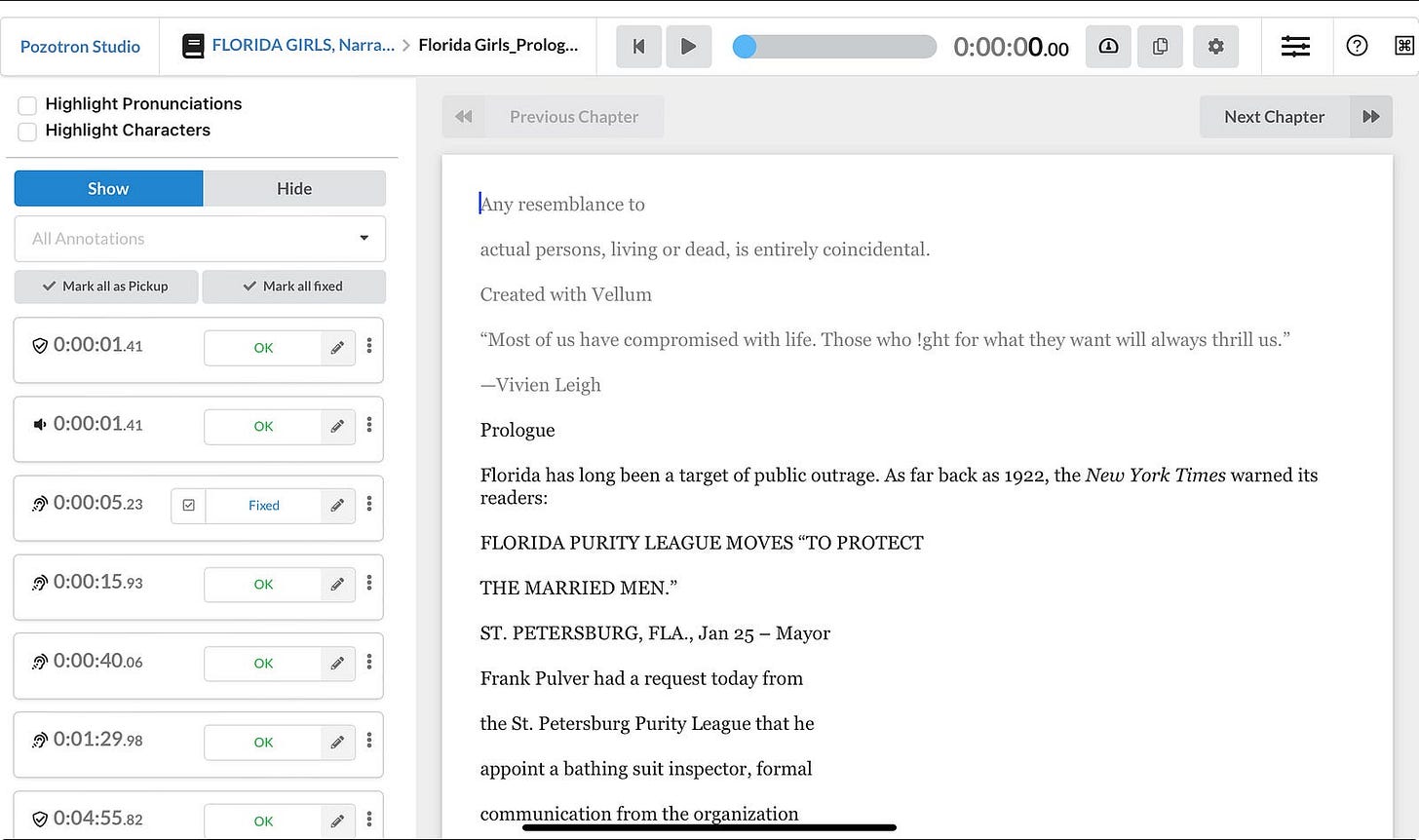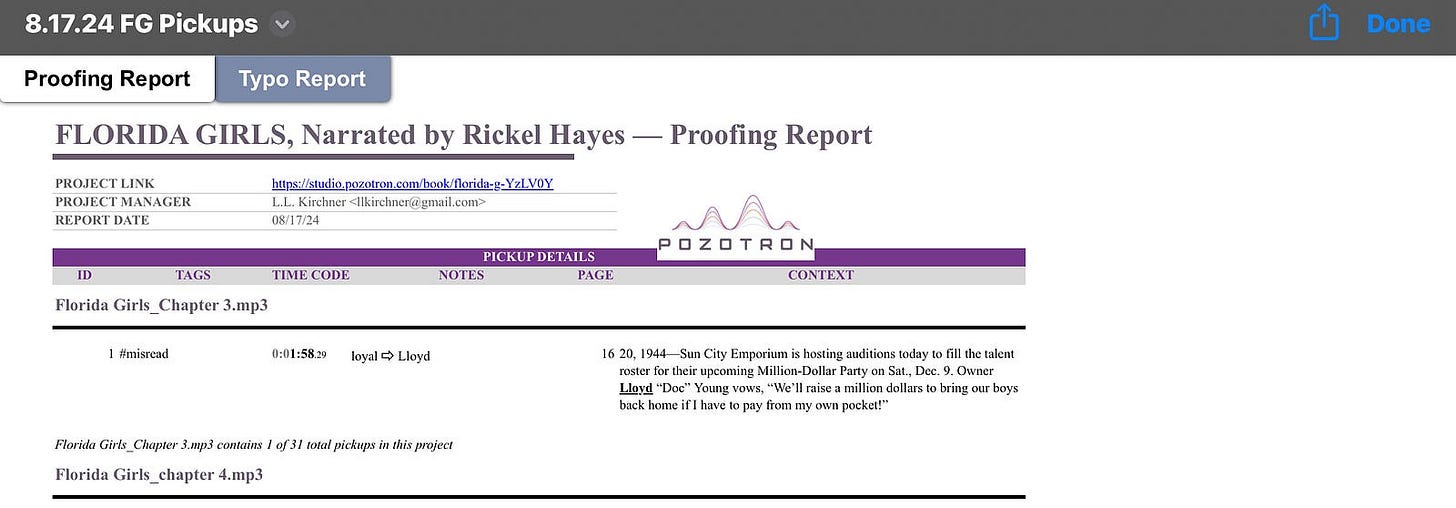Audiobook Production: A Step-by-Step Guide for Indie Authors
Learn how to create a professional audiobook using ACX, find the perfect narrator, and ensure top-quality production with this comprehensive guide for indie authors
If you’re thinking about creating an audiobook, this is for you. I go over:
How to create your project using ACX (Audible’s back end for audiobooks)
How to find your human narrator
How to create *Whispersync-ready files that will work across platforms
AMA — I’ll do my best to answer your questions
After narrating and distributing my first audiobook in 2023, I wrote a guide on how-to DIY your audiobook. In it, I promised to create another post to help indie authors figure out how to work with a narrator. This is that update, which felt especially apt when, in mid-August, my weekly books email from NPR informed me that audiobooks are now a $2 billion industry, overtaking ebooks.
While I can’t say that my audiobooks are outselling my ebooks just yet, maybe some day? One thing I’ve learned since becoming my own publisher is that my book sales change over time.
When Florida Girls — my debut historical novel — launched three months ago, my paperbacks far outsold the ebooks, and zero libraries seemed interested. Now the picture is almost a mirror image, with ebooks far outselling the hard copies and libraries picking up pace. I wouldn’t know that if I didn’t have access to the data on the back end, and I’ll be very interested to see how the audiobook changes over time. I have yet to recoup my costs for the audiobook of my memoir, Blissful Thinking: : A Memoir of Overcoming the Wellness Revolution, which released mid-October 2023.
Creating an audiobook
The two key elements of audiobook creation are narration and technical production. Narrators bring the story to life, while the technical side is editing and mastering the files.
As my own narrator for Blissful Thinking, I was responsible for the equipment and soundproofing in addition to bringing the story to life (that how-to is here). I hired out the technical side, which included a quality pass alerting me to mistakes I made in the read.
For Florida Girls, I knew I wanted to work with a voice professional. Both for the vocal expertise (lots of characters and snappy, 40s-esque banter) . I thought it would make the process much simpler. It didn’t.
Repeat: hiring out the narration did not mean I automagically had an audiobook ready to publish.
Since the narrator was responsible for turning in sound files mastered to ACX specs, I thought that was the major hurdle. I’d I tried to master about three seconds of audio to fix a mistake on my memoir, and the file was rejected by ACX (luckily my producer was kind enough to fix it).
What I failed to take into account was the work involved in the quality pass. I don’t say that to scare you off from this process but alert you to what I didn’t know when I started.
It’s the same reason I wrote the other audiobook guide—in both cases the information I needed was piecemeal and incomplete. Much of what I needed I learned only from talking directly with customer service at various platforms. So I never have to recreate the wheel, I put all the information you need to produce an Audible-ready audiobook in one place, along with searchable terms and some links for other platforms. I am not an affiliate repping anything here, just sharing my recommendations.
Once you’ve read this guide, and/or the other, you’ll know if producing your own audiobook is for you.) Highly recommend!
Each process starts the same—you must own the rights
If you’re self-published you should have no worries here, unless you used lyrics. Word of advice, don’t.
If you’re with or considering an indie press, ask to keep the audio rights. The vast majority of indie presses will not do anything to get you an audiobook deal. If you decide you want to create one, or are approached by someone who wants to produce one, or if your agent brings you a deal, the press will own a piece of the audiobook rights.
Unless your publisher plans to cover the costs of your audiobook production (ask!), there’s no reason to relinquish your rights to the material. Even if you don’t have immediate plans to produce an audiobook, you might want to hold on to those rights so you have the option to produce your own later.
Using the ACX platform
When I recorded and uploaded my memoir as an audiobook I used Findaway Voices to take advantage of their wide distribution capabilities. ACX was easier to navigate, but the main reason I used ACX is because since then, Findaway Voices has ditched its narrator talent pool offering and become an arm of Spotify, making for a different profit sharing structure. I do still use it to distribute my memoir, but that’s largely because I tend to find their help pages wanting. The mere thought of figuring out how to remove my files is unappealing and keeps dropping from my to-do list.
Conversely, ACX has customer service reps you can speak to by phone, email, or chat. And they offer a large pool of voiceover artists, including “vetted” narrators. Not all of them are, and those that are tend to be more expensive. That seal of approval was reassuring, it meant knowing their sound files would meet the platform’s exacting standards—any audiobook that works on Audible will work on the other platforms, but the same is not always true in reverse.
That said, you don’t have to use an ACX narrator. You can upload files from a narrator you find on Upwork, or Voices.com, or some other resource. Which brings us to, how to screen for your narrator.
Finding your narrator
Unless you already know who you’d like to hire, you’ll need to find someone. In fact, the person you have in mind who narrated a book you loved may be beyond your budget and/or unavailable for the foreseeable future. You may need to have some additional options.
I like the ACX tool for finding a narrator. The options are clear and it’s easy to use. Once you set up your account, you can start listening to potential voice artists in seconds. Here’s a screenshot of the back end:
Ticking the boxes on the right will narrow your search to a list of narrators who best fit your material. The options include budget, genre, languages, accents, gender, voice age, voice style and location. I was so excited to start hearing my book come to life I started here, but I don’t recommend that approach. I had to backtrack to then invite my narrators to my project.
Next time, I’ll start by creating a project.
How to create your “project”
A project is what ACX calls the folder that contains all the files for your audiobook—your audition script, any notes you want to give your potential voice artists, and ultimately all the sound files by chapter.
For Florida Girls, I was so focused on finding a narrator that I started looking for talent before I created the project. Because I searched first, I had to work backwards to set up the project and then figure out how to invite the narrators I liked to submit to it. Once I created the project however, I was flooded with even better choices. In the end I went with someone who auditioned for the project. I recommend starting with the project.
To begin, claim your title. For whatever reason, the 2nd book in The Queenpin Chronicles didn’t show up, so I popped in the ASIN.
If the book already exists on Amazon, the description will auto-populate from your book’s description. It will look terrible and you do want to fix this. (I like yaytext.com for formatting!) Then enter the rest.
NOTE: You get to pick one category here, and the choices are limited to Audible’s top-level menu. You can get around this!
Go to Audible, look at their categories. Find your top level category, then drill down into the sub-menus to find three relevant categories. Write to support@acx.com (I’ll call it Help from here on) to request the additional categories.
Next, if you’re using the ACX talent pool, pick work with a producer to narrate and record. On ACX, narrators are referred to as producers, though you, the submitter, are ultimately responsible for the production. If you’ll be uploading from an outside source, choose the second option. Both options allow you to keep your audio rights for wide, non-Audible exclusive distribution.
Choosing Between Exclusive and Non-Exclusive Distribution
This page will look different if you are uploading your own files. But the choices are similar, you’re determining how to handle the rights and royalties. You can structure it as:
Owning your files - pay all expenses up front but own the files
Royalty share - in lieu of payment the narrator splits the risk
Royalty share plus - some payment and some risk
When you own your files, you may distribute them wherever you like, including to libraries.
If you’re working with an ACX narrator, you’ll have the option to amend this decision before finalizing your narrator’s contract (presumably to give you the flexibility to do royalty share).
If you selected “use my own audio files,” you’ll be asked to make this decision right away and it can’t be changed (unless you write Help). In either case, you only get the option to switch from exclusive to non-exclusive once.
In a royalty share deal, in lieu of upfront payment, the narrator takes a percentage (with payments facilitated by ACX). Royalty share plus is simply royalties plus a smaller upfront fee. All royalty share is exclusive to Audible for seven years, though if your narrator agrees, you can buy them out.
If you go exclusive you get a better royalty rate (40% as opposed to 25%), though in no case do you get to set your own price. They base the price on hours of audio and mystery.
With Florida Girls, I’m still in experimental mode and so I set it up to be exclusive for now (it’s only binding for 90 days), but plan to switch later. In the three days the novel’s audiobook has been up, it’s selling better than my memoir’s audiobook did, but so has the novel in general. So I’m not sure if that’s from increased visibility as an Audible exclusive or not.
Filling out your project folder
Next, you’ll enter your chapter titles, or extract them from your book on Amazon. Now your project is ready for narrators. Almost.
Creating Your Audition Script
Now for the fun stuff! Hearing your book come to life.
You’ll want to extract enough material from your book to see how the narrator handles a range of elements, from characterization to emotion to tone. You don’t need to give it any special formatting, and the material doesn’t need to come from a single chapter.
In my book, Florida Girls, the world is set in the 1940s, has multiple POVs, and lots heralds in the form of radio announcements, newspaper clippings, and letters. There’s even a telegram.
To get a feel for how the narrator would handle these different aspects, I cobbled together material from several scenes and included enough set-up for the reader to understand the material. For instance, “this chapter opening is from an old-time Abbot and Costello routine and should sound like two voices.” Or, “when these characters meet, sparks fly. They should sound like they’re flirting, not fighting.”
When creating an audition, be aware that you’re asking for free labor. You can hear samples to get a sense of their range, what you need to find out is whether they get your work. Try to keep your audition limited to the shortest possible ask to get a feel for what matters most to you.
Screen the auditions
Listen to the auditions you get on headphones, to recreate the audiobook experience.
If you have notes, give them and see how they respond. If their resubmitted material still isn't right, move on. I spent waaaay too much time trying to work with one particular narrator before realizing it wasn't going to work. Some people just won't get your work, and that's fine. It's a waste of their time too. That's why I try to give a lot of info in the audition packet.
Unfortunately there's no way to pause accepting auditions until you select your narrator, and they will keep rolling in. I tried to respond to everyone who submitted, but the messaging area is one spot on this platform that's jenky.
If the reader nails the audition and/or the resubmission, congratulations! You've almost got your narrator.
The 15-minute checkpoint
After you click “make an offer,” your production will freeze to incoming auditions and your producer can begin uploading sound files directly to the project. The first 15 minutes they upload are a checkpoint.
This isn’t a screening exactly; you can ask narrators to submit something more for the audition. For instance, I loved the audition from the narrator I ended up working with, but her timing ran a smidge long. I mentioned that I wanted her to pick up the pace a notch so the read would feel snappy, like 1940s film noir. If that didn’t come across here, I would’ve moved on to the next person.
You don’t have to use the first 15 minutes of your book either. I gave my narrator a couple of high intensity chapters—only this time from a contiguous block of pages rather than a cherry-picked selection with notes—to see if she understood my book. It’s the last way out of the contract, allowing you to terminate without penalty if it’s not going well.
Just be up front with your narrator about what you’re doing in the process, and how you’d like to proceed. After the fiasco of the first narrator, I asked the person I ended up working with to submit only a few chapters at a time to start, in case something wasn’t working so we could catch it early. I’m glad we did since this came up on the pronunciation of the antagonist’s name.
The Quality Pass
This came up with the 15-minute checkpoint, and even the audition — assessing how well the read adheres to the book in content and tone. This was the step I was entirely unprepared for. Once I found my ACX-vetted narrator, I thought it was job done.
Nope.
While it’s true that Audible’s sound standards are strict and submitting correctly formatted files is absolutely a component, that’s not the same as a quality pass, where you review the playback for errors.
This means making sure all the words are said in the proper order and without mispronunciation, and that the material conveys the correct emotional tone.
Somehow I wasn’t thinking about how, even reading my memoir I made mistakes. Not on emotional tone—I nailed that. But the tech team’s quality pass revealed loads of “pickups,” sections where I got my own words wrong, including a mispronounced word that I’ve always said incorrectly, verdant. (I’d still say it wrong way).
The amount of work this entails didn’t occur to me as part of this pass until I started listening. Wow, does it become obvious what you’ve left off the page when you listen to a professional narrator read your words. Reading, noting the time stamp, and writing out the fixes meant repeatedly stopping and starting the audio. When the level of additional work this meant to complete the entire manuscript became clear, I admit, I freaked out.
Then I discovered Pozotron.*
Pozotron is AI software that will review your uploaded script and compare that to uploaded audio files, scanning for errors to generate reports. In minutes.
Being me, I double-checked Pozotron’s work by doing a few chapters on my own (which took a nightmarishly long time), and then compared my results to the program’s output. Pozotron correctly flagged more errors than I found.
Inside the report it’s possible to go right to the error, listen to the read, then determine what the fix is. And though it doesn’t pick up on tone, this setup made for a faster scan. With any luck, those tonal errors will be less present in the next book.
Not every error the software flags needs to be fixed. In the example above, the software read the epigraph as if it was the beginning of the chapter, flagging it as a “misread.” Then there are things that may not be worth changing. Maybe subbing an “a” for a “the.” If it didn’t change the meaning or make the sentence unlistenable (to my ear, of course), I left it.
This is an example of what the narrator saw:
She re-recorded from these cues.
Bonus, you may find more typos in your manuscript. Unless the narrator reads a typo as it is on the page. So, for example, if they read “from” when it should be “form,” because that’s how it appears on the page, the AI won’t flag it. If they do correct it, the word will get flagged as a misread. Either way, you have a greater chance of seeing the problem.
Using Pozotron to its full advantage could be another article, but their help section is robust and includes lots of videos. They don’t require a contract. Just pick the monthly level that works for you and cancel when you no longer need the service. It’s an extremely reasonable digital assistant that will make your audiobook better.
Almost there!
Time to get your audio approved
Once you’ve got all the errors fixed and you’re satisfied with the audiobook, it’s time to send those files to ACX for one last quality check! This can take up to ten days, thus there remains no way to set your release date unless you are working well in advance.
I thought I was, but the whole process took longer than I thought it would. Knowing what we know now, it would be much quicker. I’d estimate that once my narrator began reading, I could get a finished product to market in a month. However, the first hurdle is getting on your narrator’s schedule. In other words, plan well ahead!
To pre or not to pre (order)
ACX also offers a preorder. You must write and request your date. I did, and they kindly granted my request. However, I set up the preorder to coincide with a promotion I was running. Because this process ran longer than I thought it would, I barely managed to get the files uploaded in time to coincide with the preorder.
To my surprise, uploading the files was not enough to trigger a preorder. The material must pass quality control first. ACX kindly took off the preorder and simply made the title live as soon as it was available. That meant the title went live with zero promotion, but I’d rather that than have the file languishing. Better to start sooner next time.
When it comes to my author career I’m in it for the long haul, not a sprint.
Since I am currently doing exclusive distribution, there was nothing more for me to do. I’ll post an update on wide distribution when I add Florida Girls to a new platform.
How’d it Turn Out?
I’ve heard raves! Take a listen.
Or click here to start reading book two of The Queenpin Chronicles, VEGAS GIRLS, sometimes, what happens in Vegas stays with you.
Still need help?
You’re not alone. This is the kind of advice that sounds 100 percent reasonable, then when you try to apply it, you get stuck. I work 1-on-1 with with writers and presenters. You can find me on Instagram, Substack, and LinkedIn.
*If you’re not familiar with Whispersync, it’s when your audiobook is offered at a discount to Amazon ebook purchasers, allowing readers to easily switch between the two formats. The cost is so much less than buying just the audiobook, it became my gateway drug to audiobooks. To qualify, your files have to be a 96 percent match, or sync rate, to the text.
Your turn:
Do you think audiobooks count as reading?
What are some of your favorite audiobooks? How come??
What questions do you still have about this process? I’ll try and answer or point you to the right place!
Until next time…
*I have become an affiliate since I first wrote this, and used them again. They continue to make improvements and I will do a video on working with their software. Until then… AMA!


